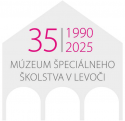Deafblindness
A combined visual and hearing impairment that restricts activities and fully-fledged involvement in work activities, social life and also access to information. Deafblindness does not mean only total loss of sight and hearing. It is the combination of different level of sight and hearing impairment.
From this point of view there are four groups of deafblind people:
people totally deaf and blind
blind people with residual hearing
deaf people with residual vision
low vision peole with hearing loss
In terms of genesis of the impairment people can have:
inborn deafblindness – since birth
acquired deafblindness:
before mastering the language
after mastering the language
Communication of people with inborn deafblindness:
non symbolic communication – for example a touch represents „go“,
using real objects – for instance a spoon represents „we are going to eat“, shoes – „we are going out“,
use of symbolic objects – for example a piece of the car set cover means that we will travel by car,
two-dimensional communication of the objects – a picture, a photo of a real object – a picture of the mother means the mother will come or you are going home,
gesticulation – natural gestures that imitate concrete activities – eating, drinking, sleeping,
sign communication – sign language,
tactile sign language,
manual communication methods based on the methods of the spoken language – finger alphabet, Braille, palm communication systems,
Lorm’s alphabet.
writing,
spoken speech – a person with inborn deafblindness learns spoken language with difficulties, but there is a very low percentage of the deafblind who learned to articulate and speak. People who became deafblind during their lives and developed the speech do not have problems to express their thoughts and deliver information because they mastered oral speech. They have problems in receiving information in communication. These people have to learn tactile communication and manual communication methods.
Communication of deafblind children and adults is highly individual and depends on the sight and hearing conditions.
Sources:
http://www.nrozp.sk/index.php/soc-rehabilitacia/hluchoslepota/93-hluchoslepota


